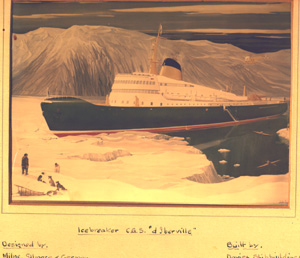As its name suggests, an icebreaker is a particular type of ship designed to break floating ice. The function of the icebreaker is quite simple. As the ship advances its bow rides onto the top of the ice until the weight of the ship becomes so heavy that the downward force of the ship causes the ice to crack and break. As the icebreaker advances, the cracked ice pieces move under the hull and the process is repeated. The resistance against the hull determines the speed of the ship as it breaks the ice and submerges the pieces.
 As
a result of advancements in the field of nautical technology and the use
of nuclear power, new icebreakers have been designed that can travel to
all parts of the world, including the North Pole. There are two main types
of icebreakers: the polar and the subpolar. The polar icebreaker remains
in polar waters. The subpolar icebreaker remains in the ice-covered waters
of coastal seas and lakes.
As
a result of advancements in the field of nautical technology and the use
of nuclear power, new icebreakers have been designed that can travel to
all parts of the world, including the North Pole. There are two main types
of icebreakers: the polar and the subpolar. The polar icebreaker remains
in polar waters. The subpolar icebreaker remains in the ice-covered waters
of coastal seas and lakes.
In his role as naval architect and designer of icebreakers, Eleanor Milne's father travelled all over the world, including Canada's far north. A treasured souvenir resting in her albums is this picture for Milne, Gilmore and German of C.G.S. d'Iberville.
Reference:
Encyclopedia of Science and Technology. New York: McGraw-Hill, 1997.
Photo of C.G.S. d'Iberville Canadian Coastguard, Department of Fisheries and Oceans.
Marine Museum of the Great Lakes at Kingston, Canada has 5, 616 naval architect design plans from 1942 through 1981 in the German and Milne Collection.
Klaus Buldt CG Icebreaker— The History of Canadian Icebreakers.
Back to Family Album page
MB